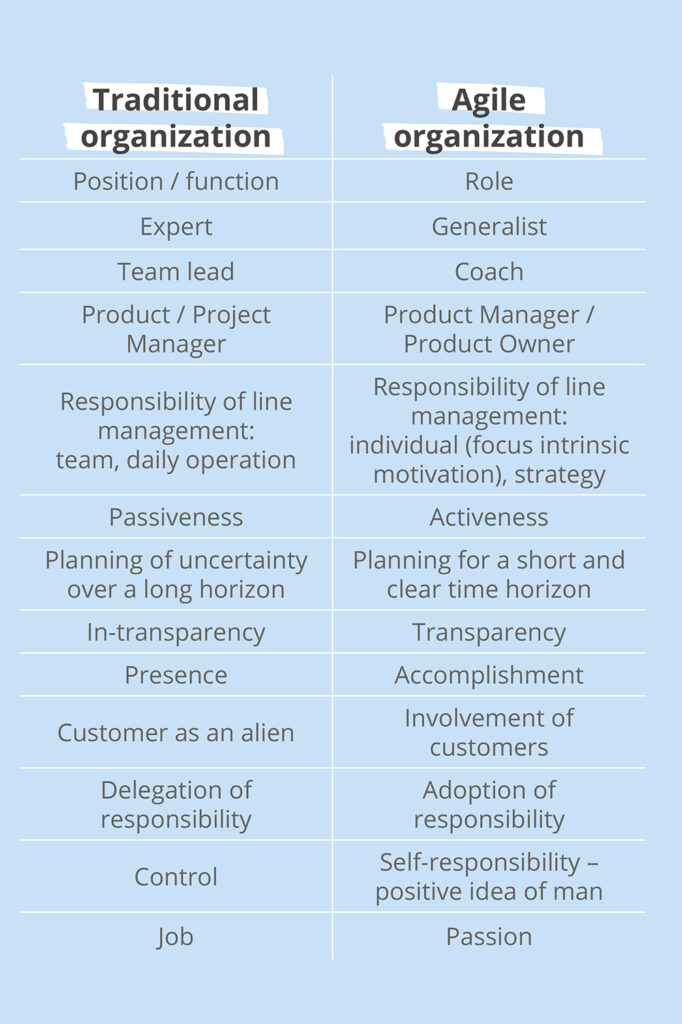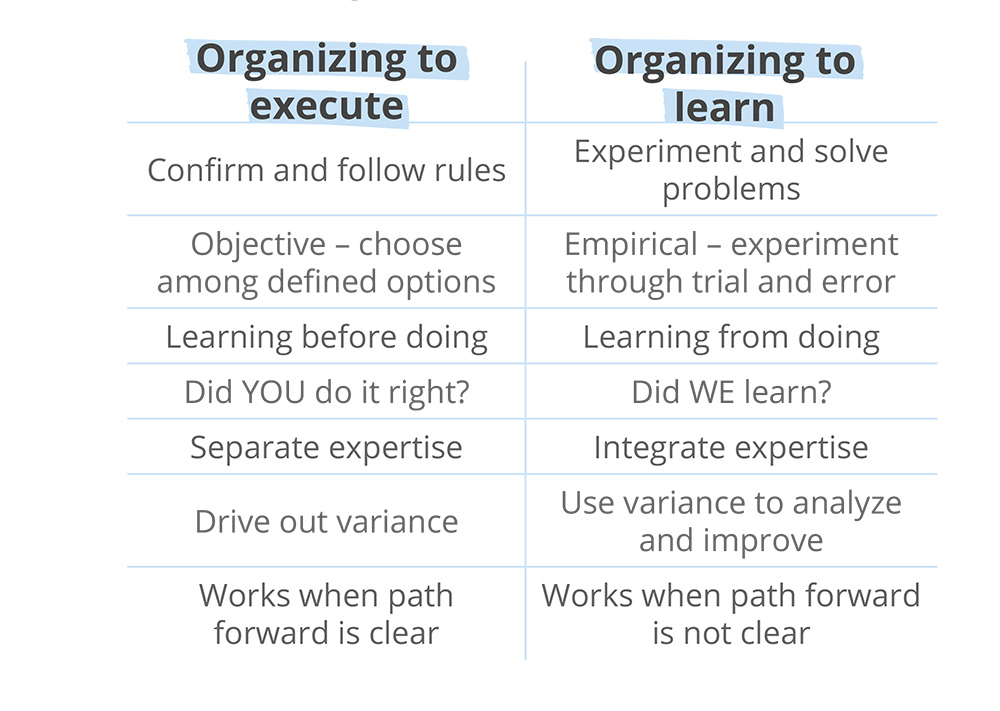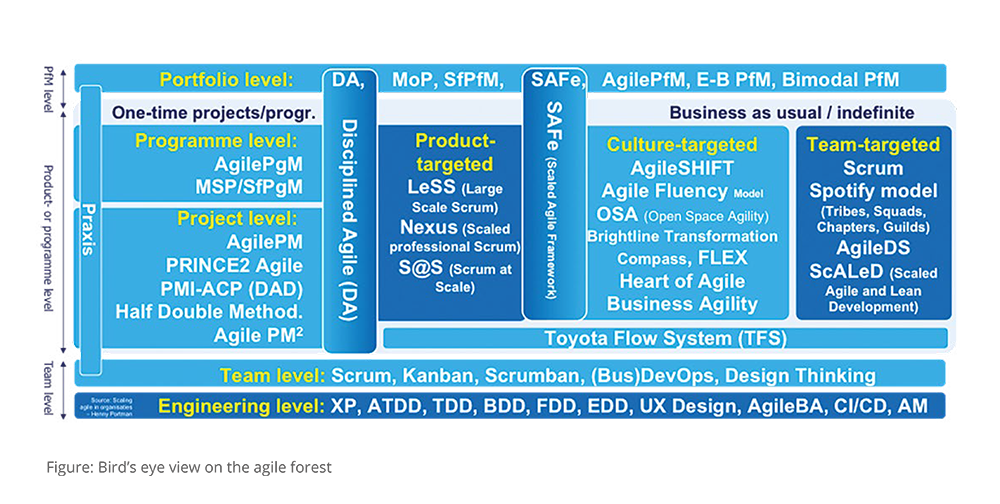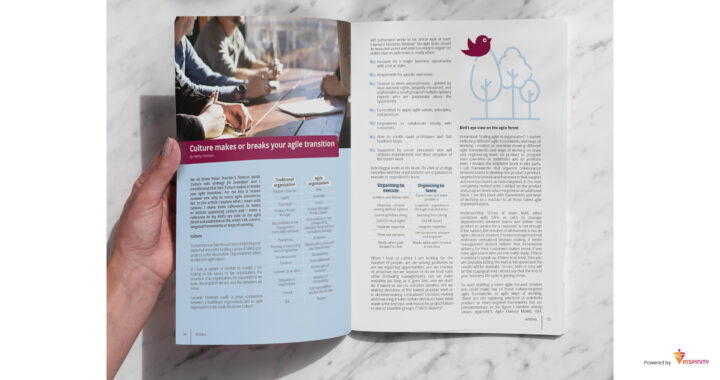By Henny Portman
We all know Peter Drucker’s famous quote ‘Culture eats strategy for breakfast’ and I transformed that into ‘Culture makes or breaks your agile transition’. For me this is reason number one why so many agile transitions fail. In this article I explain what I mean with culture, I make some references to books or articles explaining culture and I make a reference to my Bird’s eye view on the agile forest and elaborate on the, what I call, culture targeted frameworks or ways of working.
Culture
The last three or four Annual State of Agile Reports show that one of the Leading causes of failed agile projects is the observation ‘Organizational culture at odds with agile values’.
If I look at culture in relation to change, I am looking at the values of the organization, the structure of an organization, the expectations we have, the practices we use and the behaviors we show.
Dominik Maximini made a great comparison between a traditional organization and an agile organization in his book ‘The Scrum Culture’.

Jeff Sutherland wrote in his article Agile at Scale (Harvard Business Review) ‘No agile team should be launched unless and until it is ready to begin!’ He states that an agile team is ready when:
- Focused on a major business opportunity with a lot at stake
- Responsible for specific outcomes
- Trusted to work autonomously – guided by clear decision rights, properly resourced, and staffed with a small group of multidisciplinary experts who are passionate about the opportunity
- Committed to apply agile values, principles, and practices
- Empowered to collaborate closely with customers
- Able to create rapid prototypes and fast feedback loops
- Supported by senior executives who will address impediments and drive adoption of the team’s work
Jack Duggal looks in his book The DNA of strategy execution whether organizations are organized to execute or organized to learn.

When I look at culture I am looking for the mindset of people: are we solving problems or are we exploring opportunities, are we reactive or proactive, are we anxious or do we trust each other (including management), can we make mistakes (as long as it goes fast, and we don’t do it twice) or are no mistakes allowed. Are we making decisions at the lowest possible level or is decision-making centralized? Decision making and how long it takes before decisions have been made is the key topic and reason for project failure in one of Standish group’s CHAOS Reports.
Bird’s eye view on the agile forest

In my book ‘Scaling agile in organisaties’ I started collecting different agile frameworks and ways of working. I created an overview showing different agile frameworks and ways of working on team and engineering level, on product or program level (one-time or indefinite) and on portfolio level. I divided the indefinite block in two parts. I call frameworks that organize collaboration between teams to develop one product a product-targeted framework and frameworks that support autonomous teams as team-targeted. In the next completely revised print, I added on the product and program level culture-targeted as an additional block. I see this block with frameworks and ways of working as a reaction to all those failed agile implementations.
Implementing Scrum at team level, often combined with SAFe or LeSS to manage dependencies between teams and deliver one product or service for a customer, is not enough if the culture, the mindset of all involved, is not an agile culture or mindset. If senior management still embraces centralized decision making, if senior management doesn’t believe that incremental delivery for their customers makes sense, if you have agile teams who are not really ready, if there is anxiety to speak up, if there is no trust, then you are probably hitting the wall at full speed and the results will be dramatic. Scrum, SAFe or Less will be the scapegoat and I would say that the end of your business life cycle is getting closer.
To start building a more agile focused mindset you could make use of those culture-targeted agile frameworks or agile ways of working. These are not replacing one-time or indefinite product or team-targeted frameworks but are complementary. In the figure I mention among others AgileSHIFT, Agile Fluency Model, OSA, Brightline Transformation Compass and Flex. I positioned the latest version of SAFe (5.0) partially in this box too. In my (updated) award-winning article I mention many more.
To give some background behind a few of these culture-targeted frameworks:
SAFe7 (as of version 5.0) offers two extra competencies: Continuous Learning Culture (CLC) and Organizational Agility (OA).
Continuous Learning Culture is based on three dimensions: Learning Organization (shared vision, systems thinking, mental models, team learning, personal mastery), Relentless Improvement (constant sense of danger, optimize the whole, problem solving culture, reflect at key milestones, fact based improvement), and Innovation Culture (innovative people, time & space, go see, experimentation & feedback, pivot without mercy or guilt, innovation riptides). The three dimensions of Organizational Agility are: Lean-thinking people and agile teams (house of lean, SAfe principles, Agile Manifesto), Lean Business Operations (process time – delay time – process time) and Strategy Agility.
Open Space Agility (OSA)8, formulated by Daniel Mezick, 2015, is a safe, pragmatic and repeatable technique for getting a rapid and lasting Agile adoption.
It works with the approach you are currently using, and OSA can be added at any time. OSA is used to actively engage as many employees as possible in your Agile program.
AgileSHIFT9 (developed by AXELOS) is a framework that prepares people for transformational change by creating a culture of enterprise agility.
The AgileSHIFT framework helps organizations to undergo a transformational change, to adopt a ‘survive, compete and thrive’ mindset. It will help to bridge the gap between the current and the target state (the Delta in AgileSHIFT10) by embracing a range of agile, structured and hybrid approaches across the organization. The existing severe split between ‘run the business’ and ‘change the business’ will vanish.
The Agile Fluency model is a framework to help teams understand their current position and to help them develop an individual road map.
(developed by Diana Larsen and James Shore in 2012 and substantially updated in 2018)
Agile teams pass through four distinct zones of fluency as they learn (Focusing teams, Delivering teams, Optimizing teams and Strengthening teams). Diana Larsen defines fluency as things that you do automatically without thinking. Each zone brings specific benefits.
Brightline Transformation Compass, a comprehensive system for transformation developed by Behnam Tabrizi, PMI.
This approach helps to create the right mindset within your organization needed for a successful agile transformation. It gives you a compass that is built around 5 critical, mutually reinforcing building blocks for effective (North Star, customer insights & megatrends, the transformation operating system, your volunteer champions, insideout employee transformation) and a three-step approach for transformation (inspire, mobilize and shift).
FLEX13, Flow for Enterprise Transformation, developed by Al Shalloway, is designed to be used as a guide for organizations to achieve business agility.
It is a platform which lays out the steps required for improving the way a company adds value to its customers, both external and internal. It can be used with other agile frameworks like SAFe, Nexus, LeSS, Disciplined et cetera.
FLEX is designed to work at the organization level, regardless of the size of the organization involved or if only part of the organization is involved.
FLEX incorporates four shifts in thinking. These are systems-thinking, shifting from frameworks to the work itself, focusing on flow, and attending to organizational development with Lean.
Conclusion
When I look at culture I am looking for the mindset of people: are we solving problems or are we exploring opportunities, are we reactive or proactive, are we anxious or do we trust each other (including management), can we make mistakes (as long as it goes fast, and we don’t do it twice) or aren’t mistakes allowed, are we a learning organization or only existing to execute? Are we making decisions at the lowest possible level or is decision-making centralized? Decision making and how long it takes before decisions have been made is the key topic and reason for project failure in one of Standish group’s CHAOS Reports. Usage of one of the culture-targeted frameworks can help to achieve a more agile mindset and could be the missing piece in your agile transition to make it a success.
Mentioned sources:
2. Maximini, Dominik (2016). The Scrum Culture, Springer, Switzerland
3. HBR, MAY-JUNE 2018, Agile at scale
4. Standish Group, CHAOS Report 2018: Decision Latency Theory: It’s All About the Interval
5. Portman, Henny (2019), Scaling agile in organisaties, Van Haren Publishing, Zaltbommel
6. Portman, H. (2020). A new bird’s eye view on the agile forest; PM World Journal, Vol. IX, Issue X, October
7. https://www.scaledagileframework.com
8. https://openspaceagility.com
9. https://www.axelos.com/best-practice-solutions/agile-shift
10. Portman, Henny (2020), Exploring the delta in AgileSHIFT White Paper, AXELOS
11. https://martinfowler.com/articles/agileFluency.html
12. https://www.brightline.org
13. https://portal.netobjectives.com/an-overview-of-flex/
About Henny Portman
Henny Portman is a blogger / reviewer (hennyportman.wordpress.com), author, international speaker and trainer, coach and consultant for and maturity assessments of (agile) project, programme, and portfolio management.
